20.1: The Northern Renaissance
- Page ID
- 53063
The Northern Renaissance
Before 1450, Renaissance humanism had little influence outside Italy; after 1450, these ideas began to spread throughout Europe.
Learning Objectives
Describe how the Northern Renaissance differed from the Italian Renaissance
Key Takeaways
Key Points
- Humanism influenced the Renaissance periods in Germany, France, England, the Netherlands, and Poland. There were also other national and localized movements, each with different characteristics and strengths.
- Northern painters in the 16th century increasingly looked to Rome for influence, and became known as the Romanists . The High Renaissance art of Michelangelo and Raphael and the stylistic tendencies of Mannerism also had a great impact on their work.
- Although Renaissance humanism and the large number of surviving classical artworks and monuments in Italy encouraged many Italian painters to explore Greco-Roman themes, Northern Renaissance painters developed other subject matters, such as landscape and genre painting.
Key Terms
- Romanists: A group of artists in the late 15th and early 16th century from the Netherlands who began to visit Italy and started to incorporate Renaissance influences in their work.
- Northern Renaissance: The Northern Renaissance describes the Renaissance as it occurred in northern Europe.
The Northern Renaissance describes the Renaissance in northern Europe. Before 1450, Renaissance humanism had little influence outside Italy; however, after 1450 these ideas began to spread across Europe. This influenced the Renaissance periods in Germany, France, England, the Netherlands, and Poland. There were also other national and localized movements. Each of these regional expressions of the Renaissance evolved with different characteristics and strengths. In some areas, the Northern Renaissance was distinct from the Italian Renaissance in its centralization of political power. While Italy and Germany were dominated by independent city-states , parts of central and western Europe began emerging as nation-states. The Northern Renaissance was also closely linked to the Protestant Reformation , and the long series of internal and external conflicts between various Protestant groups and the Roman Catholic Church had lasting effects.
As in Italy, the decline of feudalism opened the way for the cultural, social, and economic changes associated with the Renaissance in northern Europe. Northern painters in the 16th century increasingly looked to Rome for influence, and became known as the Romanists. The High Renaissance art of Michelangelo and Raphael and the stylistic tendencies of Mannerism had a significant impact on their work. Although Renaissance humanism and the large number of surviving classical artworks and monuments in Italy encouraged many Italian painters to explore Greco-Roman themes, Northern Renaissance painters developed other subject matters, such as landscape and genre painting.
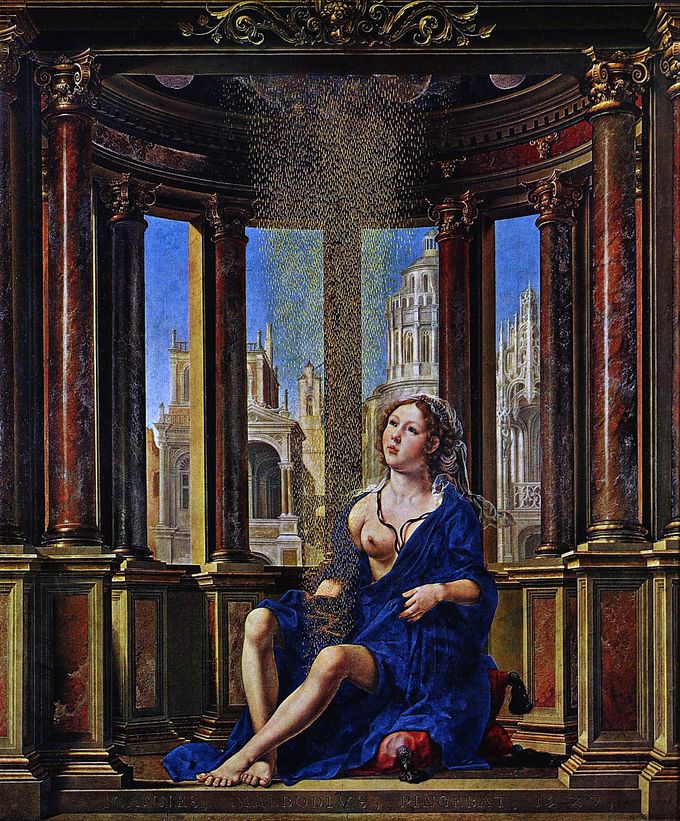
Danae by Jan Mabuse: One of the most well-known Romanists was Jan Mabuse. The influence of Michelangelo and Raphael showed in the use of mythology and nudity in this particular piece.
As Renaissance art styles moved through northern Europe, they were adapted to local customs. For example, in England and the northern Netherlands, the Reformation nearly ended the tradition of religious painting. In France, the School of Fontainebleau, which was originally founded by Italians such as Rosso Fiorentino, succeeded in establishing a durable national style. Finally, by the end of the 16th century, artists such as Karel van Mander and Hendrik Goltzius collected in Haarlem in a brief but intense phase of Northern Mannerism that also spread to Flanders .
Impact of the Protestant Reformation
The Reformation was a religious movement in the 16th century that resulted in the theological divide between Roman Catholics and Protestants.
Learning Objectives
Describe the Protestant Reformation and its effects on Western European art of the 16th century
Key Takeaways
Key Points
- Art that portrayed religious figures or scenes followed Protestant theology by depicting people and stories accurately and clearly and emphasized salvation through divine grace, rather than through personal deeds, or by intervention of church bureaucracy.
- Reformation art embraced Protestant values , although the amount of religious art produced in Protestant countries was hugely reduced. Instead, many artists in Protestant countries diversified into secular forms of art like history painting , landscapes, portraiture, and still life .
- The Protestant Reformation induced a wave of iconoclasm , or the destruction of religious imagery , among the more radical evangelists.
Key Terms
- Protestant Reformation: The 16th century schism within Western Christianity initiated by Martin Luther, John Calvin, and other early Protestants; characterized by the objection to the doctrines, rituals, and ecclesiastical structure of the Roman Catholic Church and led to the creation of Protestant churches, which were outside of the control of the Vatican.
- iconoclasm: The belief in, participation in, or sanction of destroying religious icons and other symbols or monuments, usually with religious or political motives.
The Protestant Reformation and Art
The Protestant Reformation was a religious movement that occurred in Western Europe during the 16th century that resulted in the theological divide between Roman Catholics and Protestants. This movement created a North-South split in Europe, where generally Northern countries became Protestant, while Southern countries remained Catholic. Protestant theology centered on the individual relationship between the worshiper and the divine, and accordingly, the Reformation’s artistic movement focused on the individual’s personal relationship with God. This was reflected in a number of common people and day-to-day scenes depicted in art.
The Reformation ushered in a new artistic tradition that highlighted the Protestant belief system and diverged drastically from southern European humanist art produced during the High Renaissance . Reformation art embraced Protestant values, although the amount of religious art produced in Protestant countries was hugely reduced (largely because a huge patron for the arts—the Catholic Church—was no longer active in these countries). Instead, many artists in Protestant countries diversified into secular forms of art like history painting, landscapes, portraiture, and still life.
Art that portrayed religious figures or scenes followed Protestant theology by depicting people and stories accurately and clearly and emphasized salvation through divine grace, rather than through personal deeds, or by intervention of church bureaucracy. This is the direct influence of one major criticism of the Catholic Church during the Reformation—that painters created biblical scenes that strayed from their true story, were hard to identify, and were embellished with painterly effects instead of focusing on the theological message. In terms of subject matter, iconic images of Christ and scenes from the Passion became less frequent, as did portrayals of the saints and clergy. Instead, narrative scenes from the Bible and moralistic depictions of modern life became prevalent.
The Protestant Reformation also capitalized on the popularity of printmaking in northern Europe. Printmaking allowed images to be mass produced and widely available to the public at low cost. The Protestant church was therefore able to bring their theology to the people through portable, inexpensive visual media . This allowed for the widespread availability of visually persuasive imagery. With the great development of the engraving and printmaking market in Antwerp in the 16th century, the public was provided with accessible and affordable images. Many artists provided drawings to book and print publishers.
Iconoclasm and Resistance to Idolatry
All forms of Protestantism showed a degree of hostility to religious images, especially sculpture and large paintings, considering them forms of idol worship. After the early years of the Reformation, artists in Protestant areas painted far fewer religious subjects for public display, partly because religious art had long been associated with the Catholic Church. Although, there was a conscious effort to develop a Protestant iconography of Bible images in book illustrations and prints. During the early Reformation, some artists made paintings for churches that depicted the leaders of the Reformation in ways very similar to Catholic saints. Later, Protestant taste turned away from the display of religious scenes in churches, although some continued to be displayed in homes.
There was also a reaction against images from classical mythology, the other manifestation of the High Renaissance at the time. This brought about a style that was more directly related to accurately portraying the present times. For example, Bruegel’s Wedding Feast portrays a Flemish-peasant wedding dinner in a barn. It makes no reference to any religious, historical, or classical events, and merely gives insight into the everyday life of the Flemish peasant.
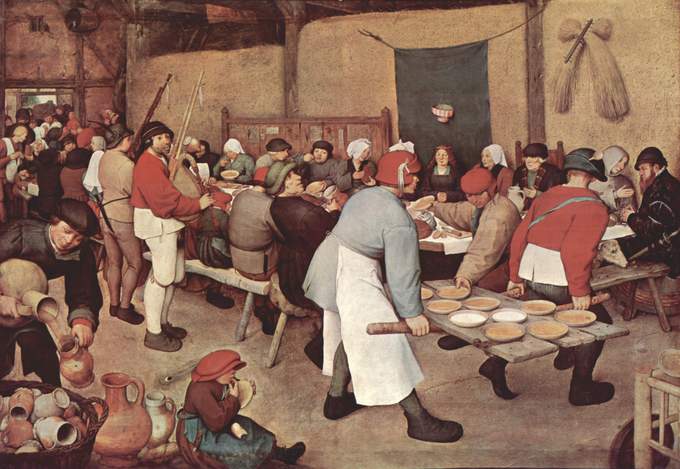
Bruegel’s Peasant Wedding: Bruegael’s Peasant Wedding is a painting that captures the Protestant Reformation artistic tradition: focusing on scenes from modern life rather than religious or classical themes.
The Protestant Reformation induced a wave of iconoclasm, or the destruction of religious imagery, among the more radical evangelists. Protestant leaders, especially Huldrych Zwingli and John Calvin, actively eliminated imagery from their churches and regarded the great majority of religious images as idolatrous—even plain crosses. On the other hand, Martin Luther encouraged the display of a restricted range of religious imagery in churches. For the most part, however, Reformation iconoclasm resulted in a disappearance of religious figurative art, compared with the amount of secular pieces that emerged.
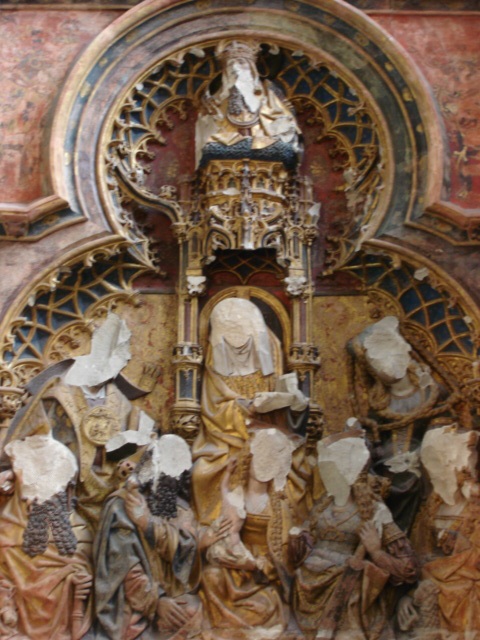
Iconoclasm: Catholic Altar Piece: Altar piece in St. Martin’s Cathedral, Utrecht, attacked in the Protestant iconoclasm in 1572. This retable became visible again after restoration in 1919 removed the false wall placed in front of it.
Antwerp: A Center of the Northern Renaissance
Antwerp, located in Belgium, was a center for art in the Netherlands and northern Europe for much of the 16th and 17th centuries.
Learning Objectives
Describe the characteristics of Antwerp Mannerism
Key Takeaways
Key Points
- The Antwerp School for painting flourished during the 16th and 17th centuries. The Antwerp School comprised many generations of artists and is known for portraiture, animal paintings, still lifes, and prints.
- Antwerp Mannerism bore no relation to Renaissance Mannerism, but the name suggests a reaction to the “classic” style of the earlier Flemish painters. Although attempts have been made to identify individual artists, most paintings remain attributed to anonymous masters.
- Antwerp was an internationally significant publishing center, with prodigious production of old master prints and book illustrations. Furthermore, Antwerp animaliers, or animal painters, such as Frans Snyders, Jan Fyt, and Paul de Vos, dominated animal painting in Europe.
Key Terms
- Antwerp School: The Antwerp School is a term for the artists active in Antwerp, first during the 16th century when the city was the economic center of the Low Countries, and then during the 17th century when it became the artistic stronghold of the Flemish Baroque under Peter Paul Rubens.
- Antwerp: A province of Flanders, Belgium.
Antwerp, located in present-day Belgium, was a center for art in the Netherlands and northern Europe for much of the 16th and 17th centuries. The so-called Antwerp School for painting flourished during the 16th century when the city was the economic center of the Low Countries, and again during the 17th century when it became the artistic stronghold of the Flemish Baroque . The Antwerp School comprised many generations of artists and is known for portraiture, animal paintings, still lifes, and prints.
Antwerp became the main trading and commercial center of the Low Countries around 1500, and the boost in the economy attracted many artists to the cities to join craft guilds . For example, many 16th century painters, artists, and craftsmen joined the Guild of Saint Luke, which educated apprentices and guaranteed quality. The first school of artists to emerge in the city were the Antwerp Mannerists , a group of anonymous late Gothic painters active in the city from about 1500 to 1520.
Antwerp Mannerism bore no direct relation to Renaissance or Italian Mannerism, but the name suggests a style that was a reaction to the “classic” style of the earlier Flemish painters. Although attempts have been made to identify individual artists, most paintings remain attributed to anonymous masters. Characteristic of Antwerp Mannerism are paintings that combine early Netherlandish and Northern Renaissance styles, and incorporate both Flemish and Italian traditions into the same compositions . Practitioners of the style frequently painted subjects such as the Adoration of the Magi and the Nativity, both of which are generally represented as night scenes, crowded with figures and dramatically illuminated. The Adoration scenes were especially popular with the Antwerp Mannerists, who delighted in the patterns of the elaborate clothes worn by the Magi and the ornamentation of the architectural ruins in which the scene was set.
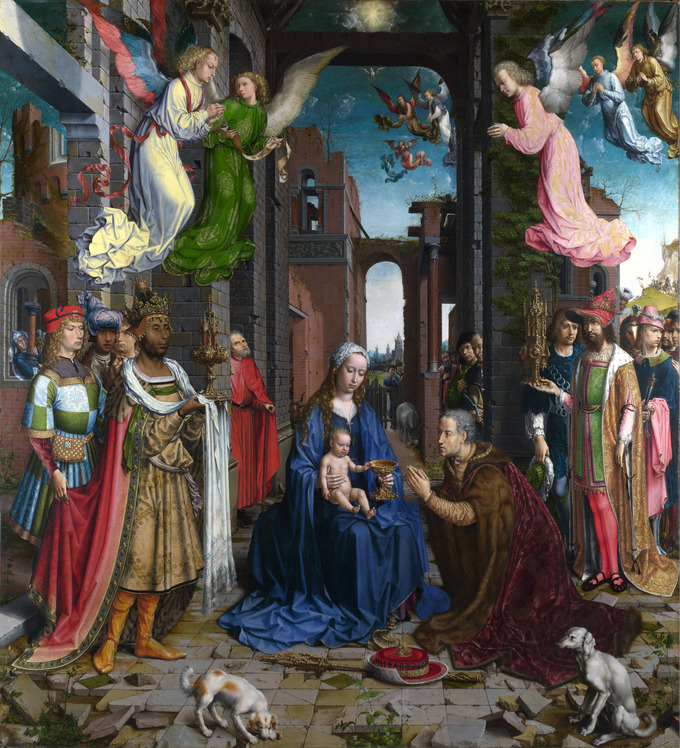
The Adoration of the Kings by Jan Gossaert: This painting captures the Antwerp Mannerist tradition of using religious themes, particularly the Adoration of the Magi, for inspiration.
The iconoclastic riots (“Beeldenstorm” in Dutch) of 1566 that preceded the Dutch Revolt resulted in the destruction of many works of religious art , after which time the churches and monasteries had to be refurnished and redecorated. Artists such as Otto van Veen and members of the Francken family, working in a late Mannerist style, provided new religious decoration. These also marked the beginning of economic decline in the city, as the Scheldt river was blockaded by the Dutch Republic in 1585 and trade restricted.
The city experienced an artistic renewal in the 17th century. The large workshops of Peter Paul Rubens and Jacob Jordaens, along with the influence of Anthony van Dyck, made Antwerp the center of the Flemish Baroque. The city was an internationally significant publishing center, with prodigious production of old master prints and book illustrations. Furthermore, Antwerp animaliers or animal painters, such as Frans Snyders, Jan Fyt ,and Paul de Vos, dominated animal painting in Europe for at least the first half of the century. But as the economy continued to decline, and the Habsburg nobility and the Church reduced their patronage , many artists trained in Antwerp left for the Netherlands, England, France, or elsewhere. By the end of the 17th century, Antwerp was no longer a major artistic center.
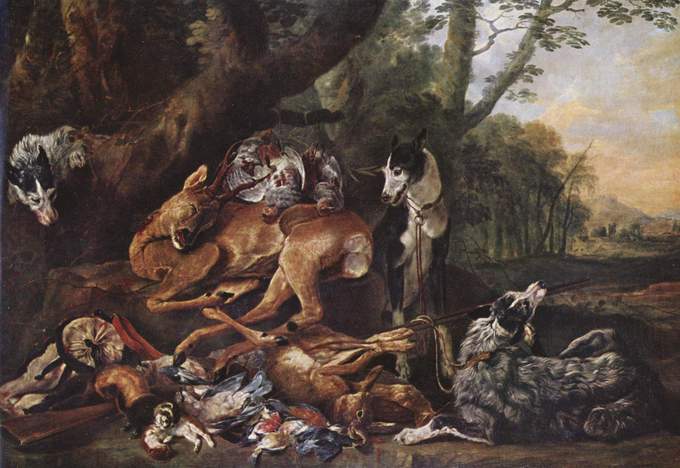
Hunting Trophies: Jan Fyt, a member of the Antwerp School, was well known for the use of animal motifs in his paintings.
- Curation and Revision. Provided by: Boundless.com. License: CC BY-SA: Attribution-ShareAlike
- Jan Gossaert 003. Provided by: Wikipedia. Located at: http://en.Wikipedia.org/wiki/File:Jan_Gossaert_003.jpg. License: Public Domain: No Known Copyright
- Northern renaissance. Provided by: Wikipedia. Located at: http://en.Wikipedia.org/wiki/Northern_renaissance. License: CC BY-SA: Attribution-ShareAlike
- Northern Renaissance. Provided by: Wikipedia. Located at: en.Wikipedia.org/wiki/Northern%20Renaissance. License: CC BY-SA: Attribution-ShareAlike
- Romanism. Provided by: Wikipedia. Located at: https://en.Wikipedia.org/wiki/Romanism_(painting). License: CC BY-SA: Attribution-ShareAlike
- Pieter Bruegel d.nu00c4.n011. Provided by: Wikipedia. Located at: http://en.Wikipedia.org/wiki/File:Pieter_Bruegel_d._%C3%84._011.jpg. License: Public Domain: No Known Copyright
- Altaarretabel Domkerk. Provided by: Wikipedia. Located at: en.Wikipedia.org/wiki/File:Altaarretabel_Domkerk.JPG. License: CC BY-SA: Attribution-ShareAlike
- The Peasant Wedding. Provided by: Wikipedia. Located at: en.Wikipedia.org/wiki/The_Peasant_Wedding. License: CC BY-SA: Attribution-ShareAlike
- The Reformation and art. Provided by: Wikipedia. Located at: en.Wikipedia.org/wiki/The_Reformation_and_art. License: CC BY-SA: Attribution-ShareAlike
- iconoclasm. Provided by: Wiktionary. Located at: en.wiktionary.org/wiki/iconoclasm. License: CC BY-SA: Attribution-ShareAlike
- Protestant Reformation. Provided by: Wikipedia. Located at: en.Wikipedia.org/wiki/Protestant%20Reformation. License: CC BY-SA: Attribution-ShareAlike
- Jan Gossaert 001. Provided by: Wikipedia. Located at: en.Wikipedia.org/wiki/File:Jan_Gossaert_001.jpg. License: Public Domain: No Known Copyright
- Jan Fyt 001. Provided by: Wikipedia. Located at: en.Wikipedia.org/wiki/File:Jan_Fyt_001.jpg. License: Public Domain: No Known Copyright
- The Adoration of the Kings (Gossaert). Provided by: Wikipedia. Located at: en.Wikipedia.org/wiki/The_Adoration_of_the_Kings_(Gossaert). License: CC BY-SA: Attribution-ShareAlike
- Antwerp Mannerism. Provided by: Wikipedia. Located at: en.Wikipedia.org/wiki/Antwerp_Mannerism. License: CC BY-SA: Attribution-ShareAlike
- Antwerp school. Provided by: Wikipedia. Located at: en.Wikipedia.org/wiki/Antwerp_school. License: CC BY-SA: Attribution-ShareAlike
- Antwerp School. Provided by: Wikipedia. Located at: en.Wikipedia.org/wiki/Antwerp%20School. License: CC BY-SA: Attribution-ShareAlike
- Antwerp. Provided by: Wiktionary. Located at: en.wiktionary.org/wiki/Antwerp. License: CC BY-SA: Attribution-ShareAlike

